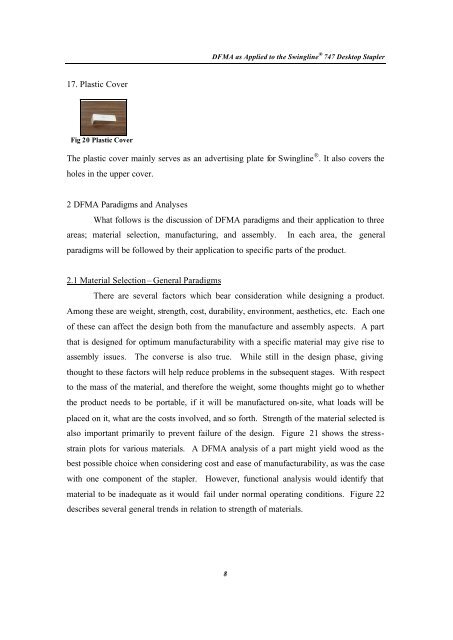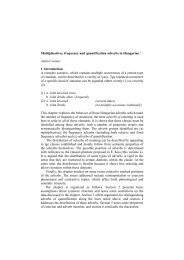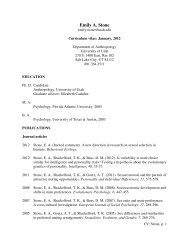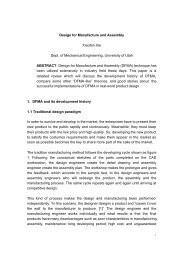DFMA as Applied to the Swingline 747 Desktop ... - University of Utah
DFMA as Applied to the Swingline 747 Desktop ... - University of Utah
DFMA as Applied to the Swingline 747 Desktop ... - University of Utah
Create successful ePaper yourself
Turn your PDF publications into a flip-book with our unique Google optimized e-Paper software.
17. Pl<strong>as</strong>tic Cover<br />
Fig 20 Pl<strong>as</strong>tic Cover<br />
<strong>DFMA</strong> <strong>as</strong> <strong>Applied</strong> <strong>to</strong> <strong>the</strong> <strong>Swingline</strong> ® <strong>747</strong> Desk<strong>to</strong>p Stapler<br />
The pl<strong>as</strong>tic cover mainly serves <strong>as</strong> an advertising plate for <strong>Swingline</strong> ® . It also covers <strong>the</strong><br />
holes in <strong>the</strong> upper cover.<br />
2 <strong>DFMA</strong> Paradigms and Analyses<br />
What follows is <strong>the</strong> discussion <strong>of</strong> <strong>DFMA</strong> paradigms and <strong>the</strong>ir application <strong>to</strong> three<br />
are<strong>as</strong>; material selection, manufacturing, and <strong>as</strong>sembly. In each area, <strong>the</strong> general<br />
paradigms will be followed by <strong>the</strong>ir application <strong>to</strong> specific parts <strong>of</strong> <strong>the</strong> product.<br />
2.1 Material Selection – General Paradigms<br />
There are several fac<strong>to</strong>rs which bear consideration while designing a product.<br />
Among <strong>the</strong>se are weight, strength, cost, durability, environment, aes<strong>the</strong>tics, etc. Each one<br />
<strong>of</strong> <strong>the</strong>se can affect <strong>the</strong> design both from <strong>the</strong> manufacture and <strong>as</strong>sembly <strong>as</strong>pects. A part<br />
that is designed for optimum manufacturability with a specific material may give rise <strong>to</strong><br />
<strong>as</strong>sembly issues. The converse is also true. While still in <strong>the</strong> design ph<strong>as</strong>e, giving<br />
thought <strong>to</strong> <strong>the</strong>se fac<strong>to</strong>rs will help reduce problems in <strong>the</strong> subsequent stages. With respect<br />
<strong>to</strong> <strong>the</strong> m<strong>as</strong>s <strong>of</strong> <strong>the</strong> material, and <strong>the</strong>refore <strong>the</strong> weight, some thoughts might go <strong>to</strong> whe<strong>the</strong>r<br />
<strong>the</strong> product needs <strong>to</strong> be portable, if it will be manufactured on-site, what loads will be<br />
placed on it, what are <strong>the</strong> costs involved, and so forth. Strength <strong>of</strong> <strong>the</strong> material selected is<br />
also important primarily <strong>to</strong> prevent failure <strong>of</strong> <strong>the</strong> design. Figure 21 shows <strong>the</strong> stress-<br />
strain plots for various materials. A <strong>DFMA</strong> analysis <strong>of</strong> a part might yield wood <strong>as</strong> <strong>the</strong><br />
best possible choice when considering cost and e<strong>as</strong>e <strong>of</strong> manufacturability, <strong>as</strong> w<strong>as</strong> <strong>the</strong> c<strong>as</strong>e<br />
with one component <strong>of</strong> <strong>the</strong> stapler. However, functional analysis would identify that<br />
material <strong>to</strong> be inadequate <strong>as</strong> it would fail under normal operating conditions. Figure 22<br />
describes several general trends in relation <strong>to</strong> strength <strong>of</strong> materials.<br />
8





